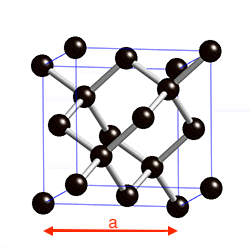Structural and electronic properties of semiconductors and metals: Difference between revisions
| Line 51: | Line 51: | ||
K_POINTS {automatic} | K_POINTS {automatic} | ||
4 4 4 0 0 0 | 4 4 4 0 0 0 | ||
The input file for PWscf is structured in a number of '''NAMELISTS''' and '''INPUT CARDS''': | |||
&NAMELIST1 ... / | |||
&NAMELIST2 ... / | |||
&NAMELIST3 ... / | |||
INPUT_CARD1 | |||
.... | |||
.... | |||
INPUT_CARD2 | |||
.... | |||
.... | |||
Revision as of 11:46, 1 December 2020
Prev: LabQSM#Lecture 1: Basic DFT calculations and Convergences
Structural and electronic properties of Diamond

In this tutorial we will see how to setup a calculation and to get total energies using the PW code from the Quantum ESPRESSO distribution.
Some helpful conversions:
1 bohr = 1 a.u. (atomic unit) = 0.529177249 angstroms.
1 Rydberg = 13.6056981 eV
1 eV =1.60217733 x 10-19 Joules
For all first-principles calculations, you must pay attention to two convergence parameters. The first one is the energy cutoff, which is the max kinetic energy used in wave-function expansion. The second is the number of k-points, which measures how well the continuous integral over the BZ is discretized.

Diamond is a face-centered cubic structure with two C atoms at 0 0 0 and 0.25 0.25 0.25 a is the lattice parameter
Now let's see in detail how a QE input is structured to make a total energy calculation for this system. An example can be found in ~/LabQSM/LAB_1/test_diamond/scf.diamond.in that you can read e.g. using the editor vi:
&CONTROL
prefix='diamond',
calculation = 'scf'
restart_mode='from_scratch',
pseudo_dir = './pseudo/'
outdir = './SCRATCH'
/
&SYSTEM
ibrav = 2,
celldm(1) = 6.7402778
nat = 2,
ntyp = 1,
ecutwfc = 40.0
/
&ELECTRONS
mixing_mode = 'plain'
mixing_beta = 0.7
conv_thr = 1.0d-8
/
ATOMIC_SPECIES
C 12.011 C.pz-vbc.UPF
ATOMIC_POSITIONS (alat)
C 0.00 0.00 0.00
C 0.25 0.25 0.25
K_POINTS {automatic}
4 4 4 0 0 0
The input file for PWscf is structured in a number of NAMELISTS and INPUT CARDS:
&NAMELIST1 ... / &NAMELIST2 ... / &NAMELIST3 ... / INPUT_CARD1 .... .... INPUT_CARD2 .... ....